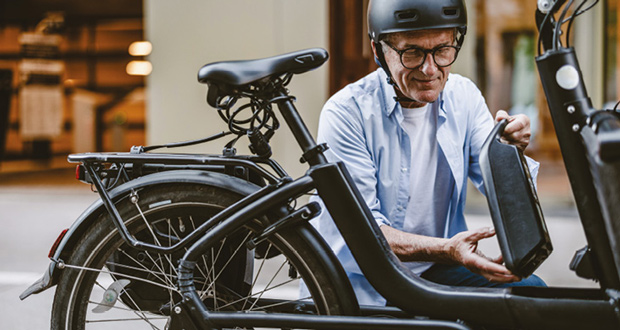 Brenig Moore, Technical Direct for Astutis offers advice on the safe storage of e-bikes in workplace premises
Brenig Moore, Technical Direct for Astutis offers advice on the safe storage of e-bikes in workplace premises
Lithium-ion battery fires from e-bikes and e-scooters are escalating rapidly, placing communal and workplace environments at serious risk. Between 2022 and 2024, lithium-ion battery fires in the UK rose by a whopping 93 per cent, with a large proportion of these involving e-bikes, according to a report Electrical Safety First. The report also revealed that, in London alone, an e-bike or e-scooter fire occurs every two days on average.
These figures represent a massive growing risk as more people invest in e-bikes and e-scooters, which is why action is needed when it comes to these modes of transport.
The reports have shown that there were eight fatalities and 86 injuries linked to these incidents last year. When it comes to looking at specific hotspots, London accounted for 175 of those 211 fires and in many incidents, these fires occurred indoors in places such as corridors and offices.
Offices are meant to be safe havens, and not a place of risk. Employers absolutely need to treat e-bikes and e-scooters differently, as they would for someone cycling to the office or driving, and additional risk testing and policies need to be put into place for employees who are set on using this method of transport to get to work.
There have been several warnings that e-bikes and e-scooters are one of the UK’s fastest-growing fire risks. The data is stark, and lithium-ion failures are often fuelled by poor compliance, irregular testing and modification of e-mobility products.
Any business that ignores this rapidly growing trend of e-bikes and e-scooters is putting its entire workforce at risk.
WHAT DO BUSINESSES NEED TO DO?
E-bikes and e-scooters powered by lithium-ion batteries present a serious risk for businesses that have communal areas and many workers on site if they’re not managed proactively.
It is imperative that organisations that have employees who travel using an e-bike or e-scooter assess how and where they’re stored and ensure that they’ve had regular testing to make sure that they’re safe to store in the office throughout the day.
Because e-bikes and e-scooters are still brand new to many people, the first instinct would be to ban them from the office completely, but as this will impact occupants who already rely on them, instead, instigate a process to ensure that the e-bikes and e-scooters are closely monitored.
The first thing to do is carry out a full fire risk assessment. This will include looking at where e-bikes and e-scooters are stored and charged, especially communal areas such as sheds, garages, corridors and storage cupboards. These locations can amplify the risk if not managed properly.
You should also limit or ban unapproved charging, and no business should allow charging of unverified or modified e-bikes on site. The risk posed by non-original, non-compliant and untested chargers is too high, and it isn’t worth putting anyone in the office at risk. If charging must occur at the workplace for someone to get home safely, then this must be done with approved chargers only.
The charging equipment should be PAT-tested regularly and should be analysed for frayed or faulty cables. Using cheaper alternatives to approved chargers should be a no-go, and this will help limit hazards.
FIRE RISK ASSESSMENTS
Fire risk assessments need to be contemporary to the evolving needs of the workplace, which is one of the reasons the dangers may have been overlooked. All such assessments should now include e-bike and e-scooter storage and charging as a specific hazard, which should also include risk-mitigating controls that are clearly documented and reviewed frequently without question.
Devices must not be stored or charged along evacuation routes. If stored indoors, then you should choose rooms with door closures and working smoke alarms. They should never be stored in hallways, stairwells, or other critical escape paths.
Employees should understand the risks associated with lithium-ion batteries. Even if nobody yet uses this mode of transport, they might one day. Advise of safer charging protocols, such as never leaving the device alone while charging and only using approved chargers.
If demand increases for e-bikes and e-scooters, then businesses can start thinking about dedicated charging stations and fire suppression. Any policies and guidance that you put in place now could stop not just one, but several injuries or fatalities.
IN SUMMARY
The scale and pace of e-bikes and e-scooters are deeply concerning, and with several tragic fatalities already being recorded, businesses need to act now to ensure the safety of their employees.
Thorough risk assessments, banning unapproved charging, ensuring proper equipment testing and updating fire protocols frequently should be top of the priority list.
Ignorance is no longer an option, nor is inaction. Let’s face this risk head-on and make our workplaces safe for everyone.
In association with www.astutis.com





